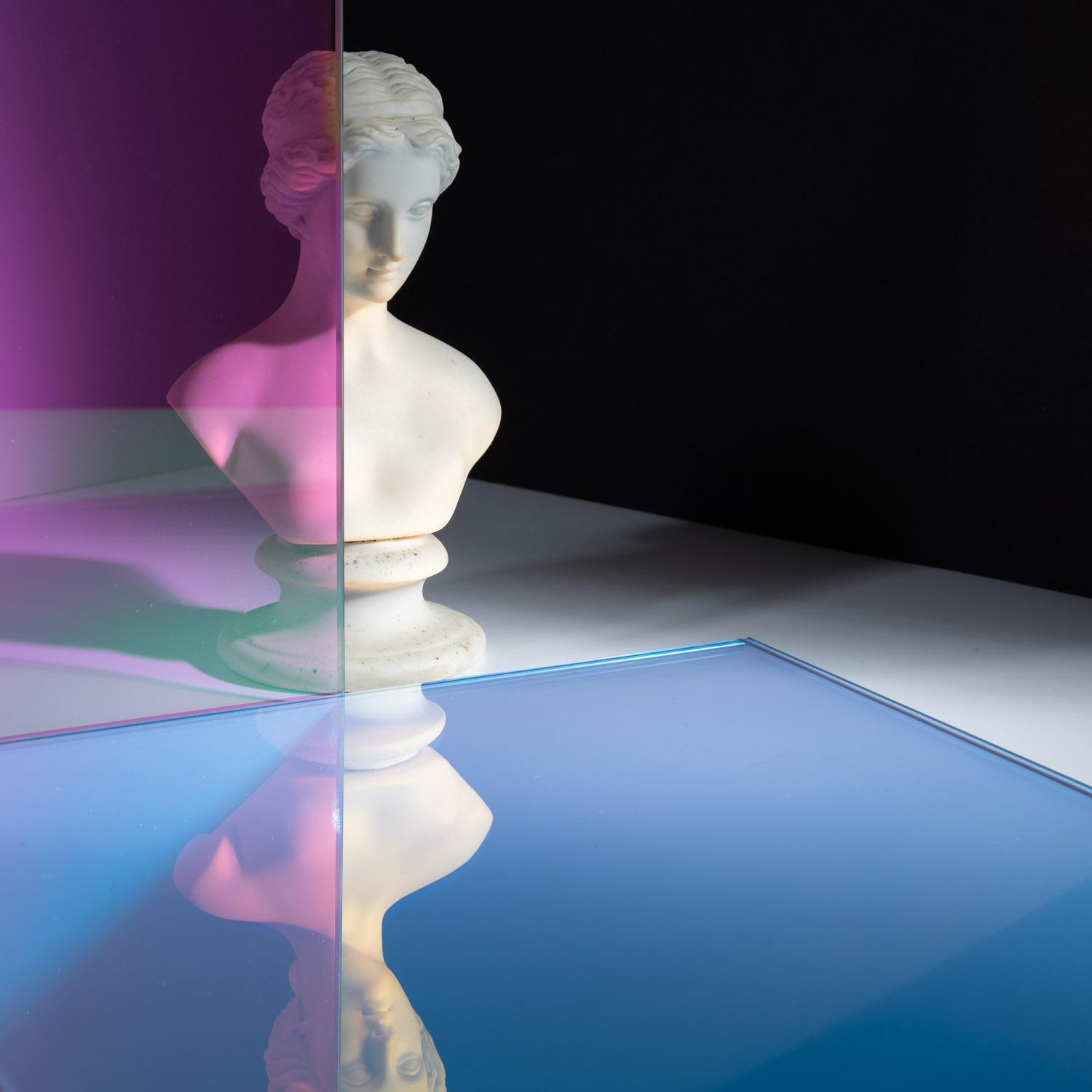Make Sure You’re Getting True Dichroic Glass
- Details
Not All Dichroic Glass Is Created Equal…Know What You’re Getting
Are you looking for the striking beauty and originality of dichroic glass? Then it’s important to realize not all versions of this product are the same. Variations in manufacturing techniques can mean differences in appearance, durability, customization options, and overall quality. As you’re deciding which glass manufacturer to choose, make sure you know the key differences between laminated dichroic glass and true dichroic glass.
Two Different Ways to Create Dichroic Glass
There are two primary manufacturing techniques to create what is known as dichroic glass.
(For an overview of the product in general, check out What Is Dichroic Glass?)
- Laminated Film: With this technique, glass manufacturers laminate a color-changing film onto the sheet of glass. This film shifts and changes colors from different viewing angles.
- Metal Deposition Chamber: Unlike with the laminated technique, this creates “true” dichroic glass. The end result is a monolithic solid sheet of glass. After being put through the metal deposition chamber, the glass ends up with extremely thin layers of metal condensed on its surface. There are usually between thirty and fifty layers, all of which add up to only about 30 millionths of an inch thick.
Benefits of True Dichroic Glass
-
Quality

True dichroic glass (dichroic glass created in a metal deposition chamber) is a higher-quality product than dichroic glass created with laminated film.
Because the materials and machinery required to create laminated dichroic glass are relatively inexpensive and widely available, this is the majority of what you see in the market today.
A metal deposition chamber, however, is an intricate and costly piece of machinery. Not nearly as many glass manufacturers have access to this equipment or the technical know-how to operate it properly.
To ensure you get the higher-quality glass for your project, ask your manufacturer about their process to create dichroic glass.
-
Durability
Because the visual effect of laminated dichroic glass comes from a relatively inexpensive piece of film, the durability of that dichroic glass is not as high.
Using the metal deposition chamber vaporizes transparent oxides of various metals. The vapor then condenses on the glass sheet, creating a permanent dichroic product.
Depending on how you plan to use your dichroic glass and what environments and stressors it will be exposed to, you might or might not need the durability of true dichroic glass.
Always discuss with your glass manufacturer the details of your project. They can recommend which option makes the most sense for your needs.
-
Depth of Color and Overall Aesthetics

"Fragmenta," by Studio Osman Akan, State of Alaska Public Art Collection
True dichroic glass offers a richer, more dramatic viewing experience.
With laminated film, you’re limited by the visual characteristics of that film. When you use a metal deposition chamber, you’re creating upwards of fifty ultra-thin metal layers on that glass substrate.
Every minute change in viewing angle manifests in a new, vibrant tint and hue to the glass.
If you’re looking to create something like an art installation or the design centerpiece of your business, the stunning visual nature of true dichroic glass could be exactly what you need.
-
Customization
If you’re leaning toward true dichroic glass, know there are important differences even between glass manufacturers who offer this product.
Some manufacturers, for example, only offer small glass panels of true dichroic glass. Depending on the scope and design of your project needs, you might require single panes in larger sizes.
Before committing to any given manufacturer, discuss the exact details of your project to ensure that company can fulfill what you want.
“If you have an extensive, ambitious project that requires large sheets of dichroic glass, reach out to us about DichroGlass™,” says Tim Casey, president and founder of Jockimo. “We’re the only company in the world that offers true dichroic sheets of glass in large sizes.”
Beyond size, true dichroic glass can also be fabricated in more custom ways:
- Shapes
- Notches
- Holes
- Tempering
“If you’re looking for tempered glass, go with true dichroic. Laminated dichroic glass cannot temper easily,” says Casey. “With the film, there’s also delamination issues to contend with.”
Get All Your Questions about Dichroic Glass Answered
Interested in learning more about dichroic glass? Want more details on the different manufacturing processes and which product would be right for you?
Reach out today. We’re Jockimo, and for decades we’ve specialized in custom architectural glass products.
We’re always happy to answer any questions you have!



